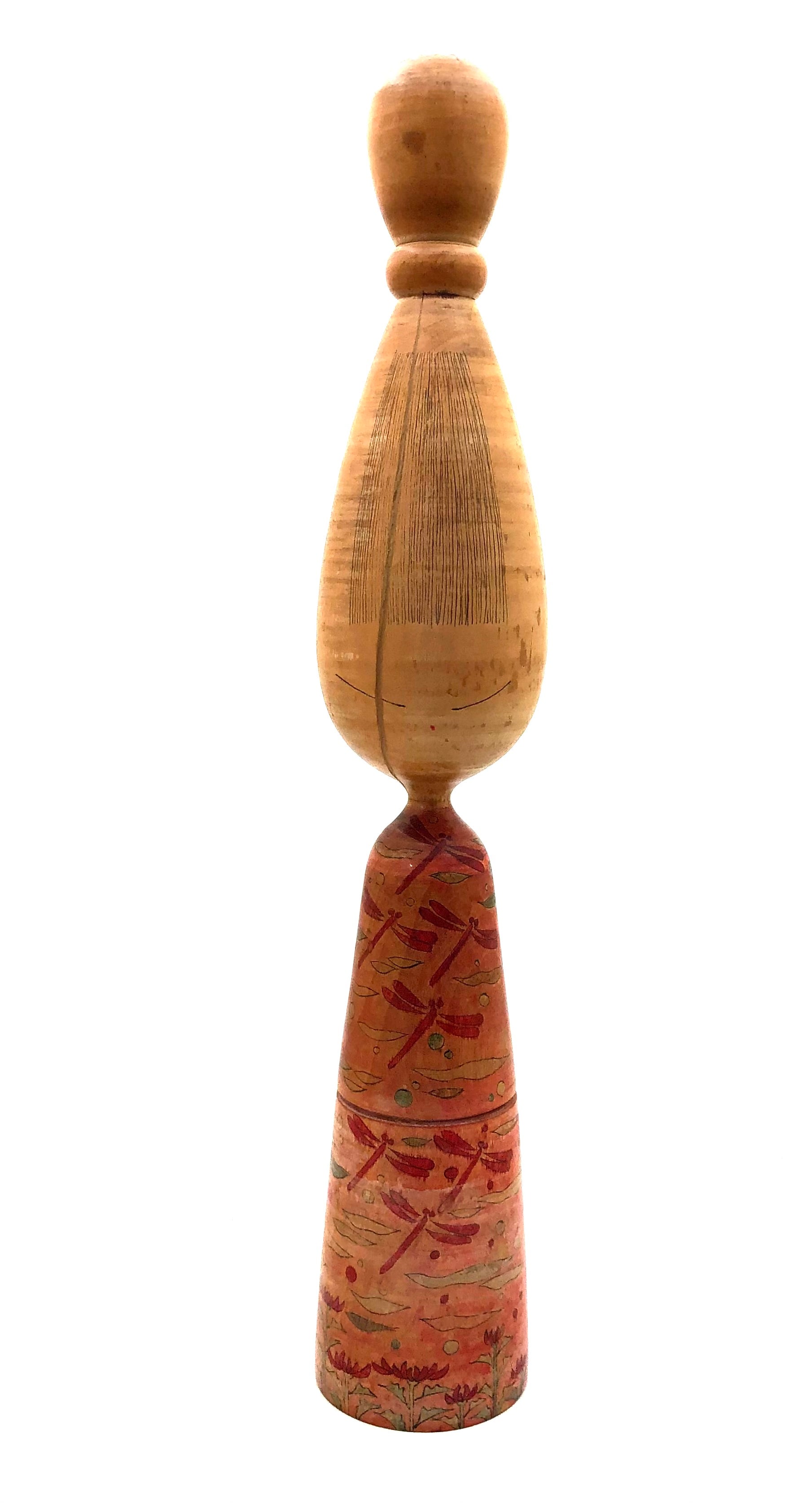
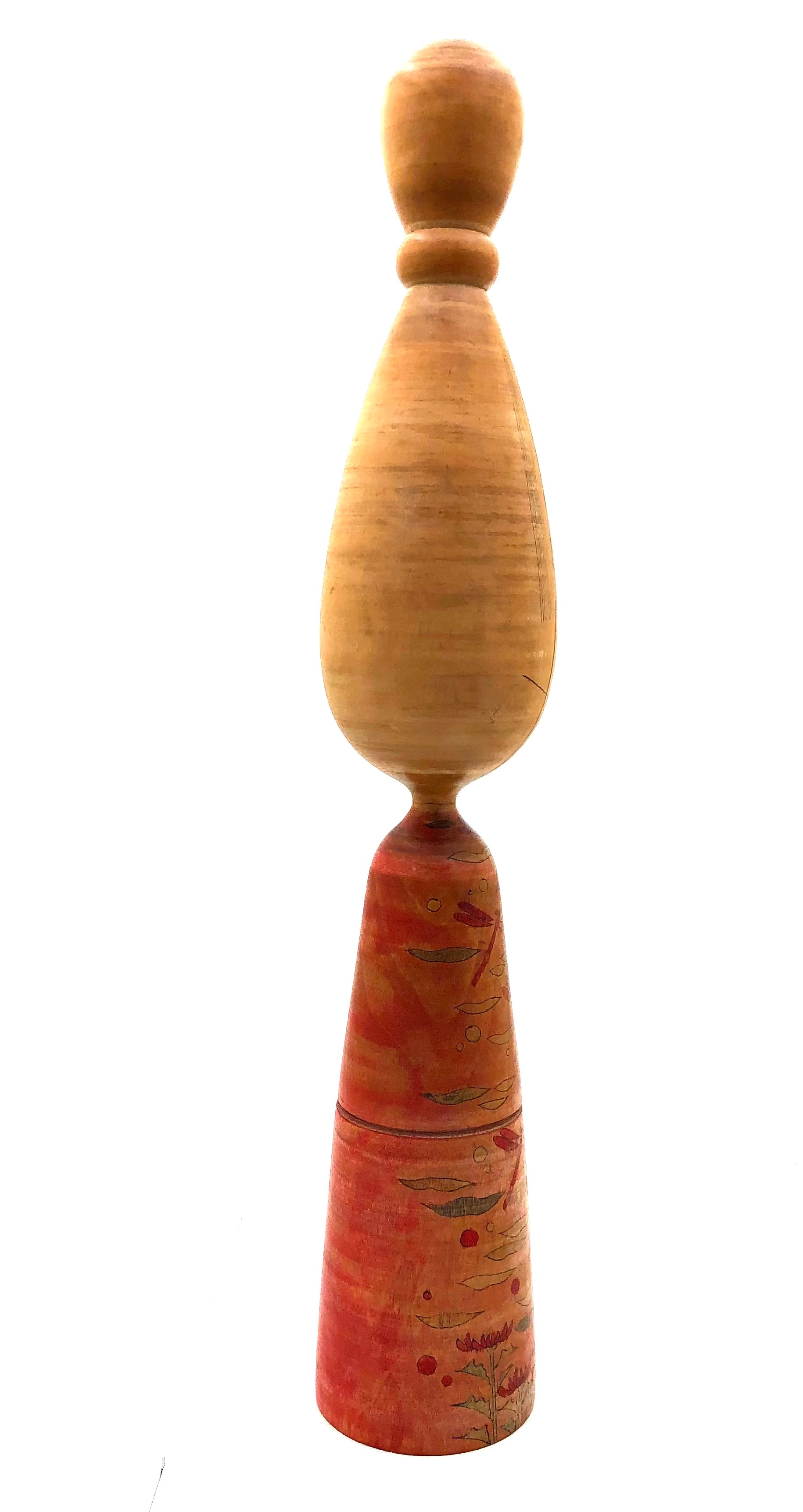
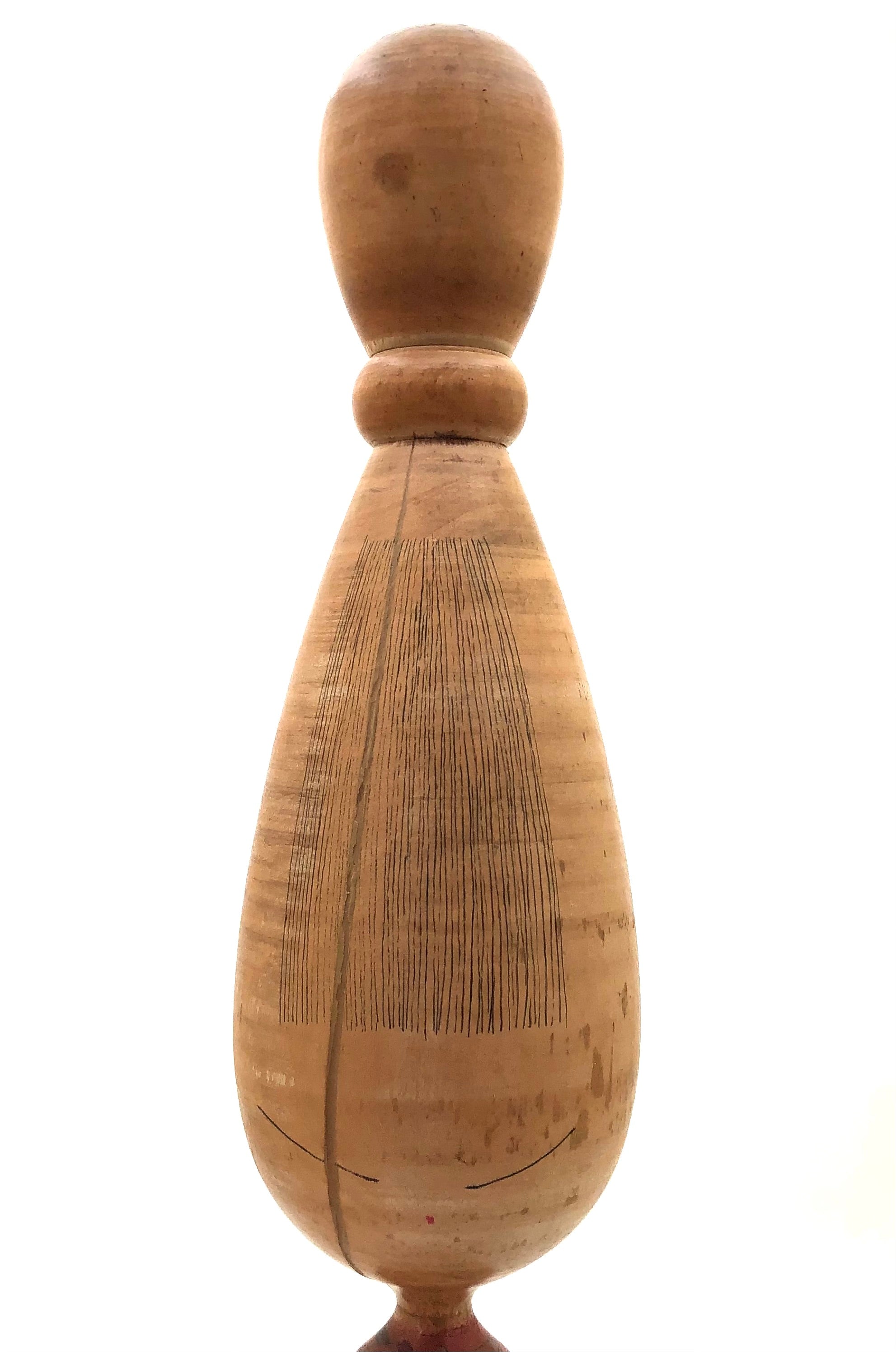

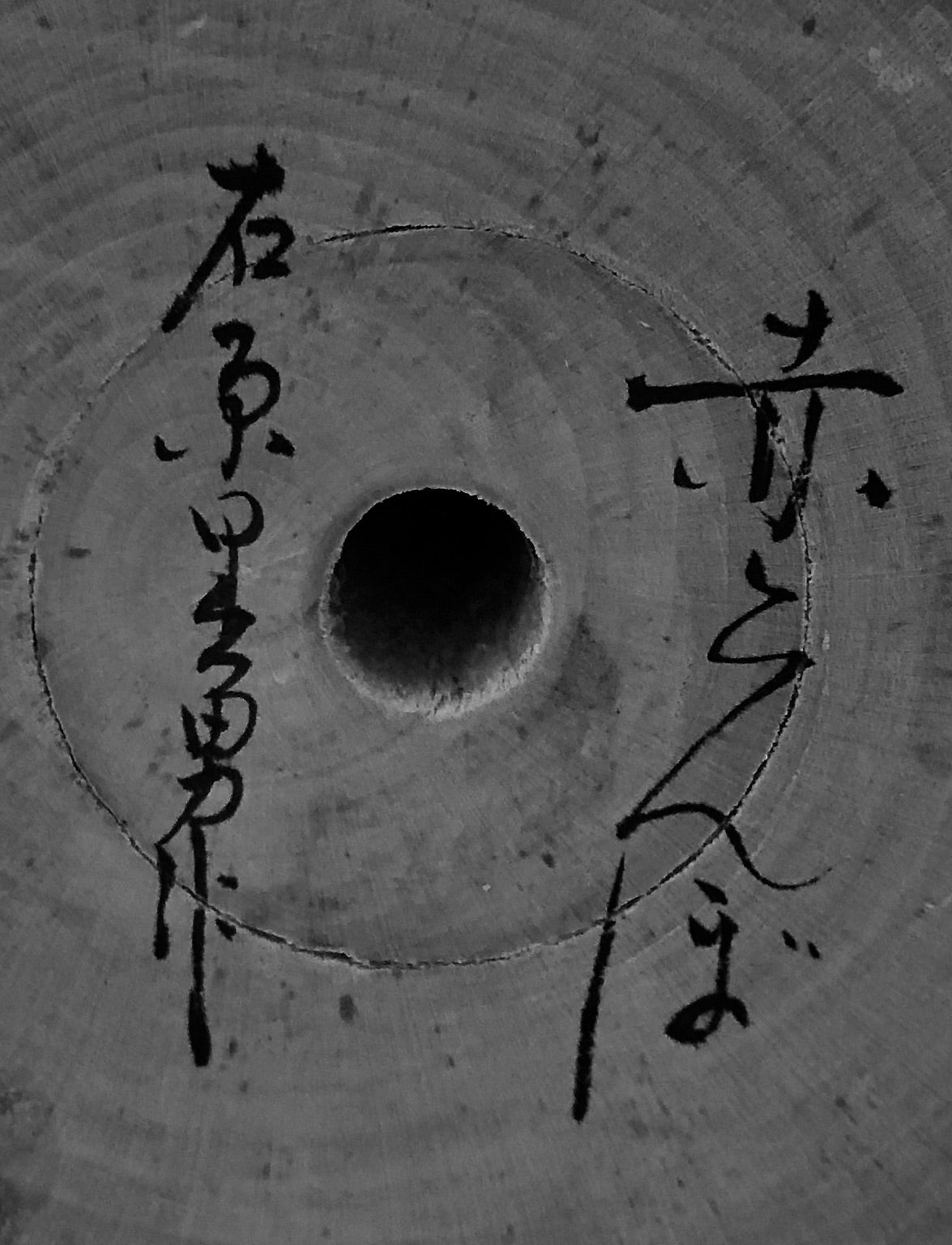
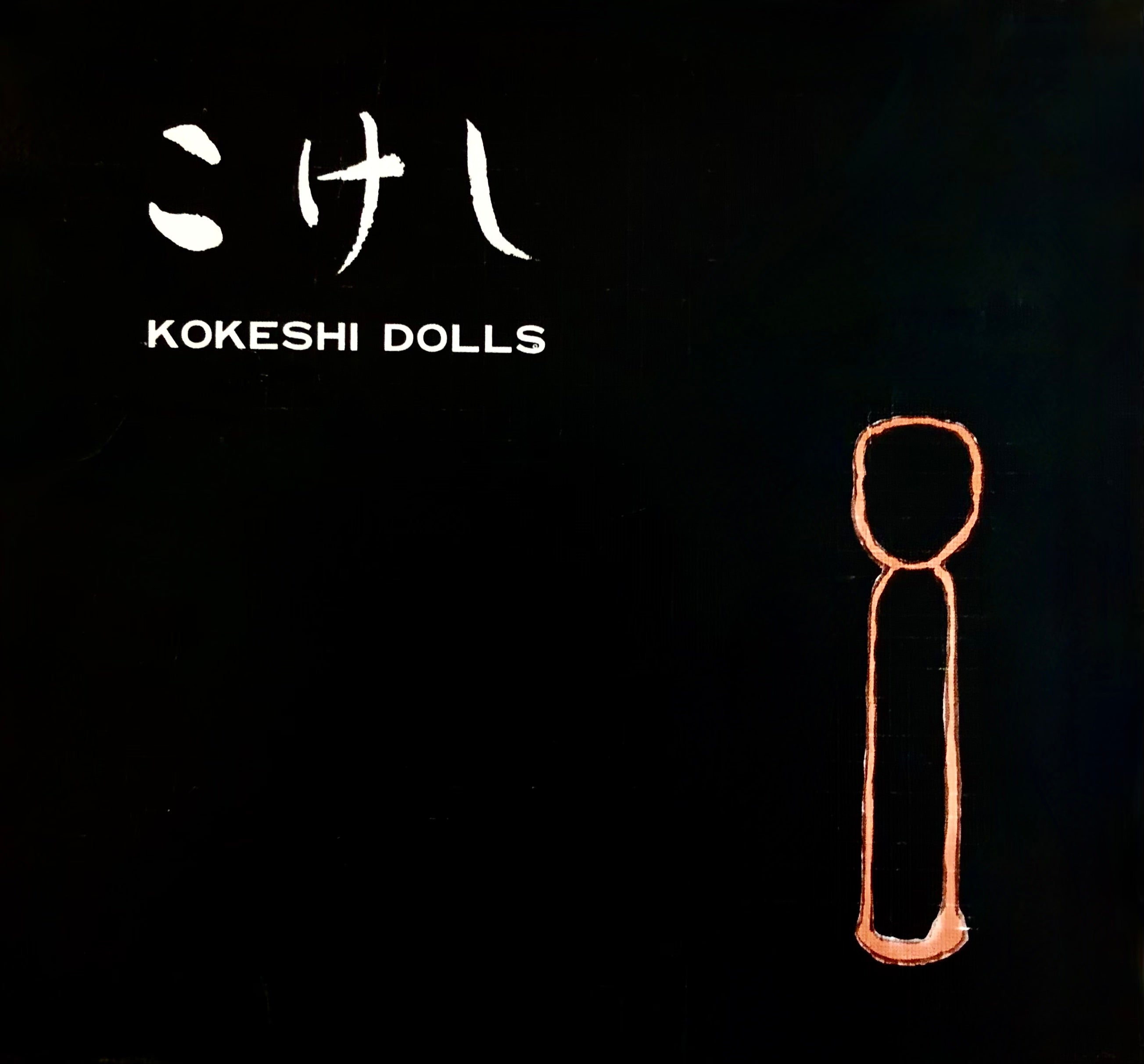

Vintage Japanese Sosaku Kokeshi entitled: “Akatonbo | Red Dragonfly” by Ishihara, Hideo
Dimensions: 21-1/2'h
We have held onto this unique and unusual Kokeshi since it was purchased in 1980, from a Japanese dealer in Osaka who was originally from Tokyo and represented Ishihara and his work. This is one of the first and largest Sosaku Kokeshi produced by Ishihara-san after he discontinued making traditional Narugo Kokeshi in 1957. The reason we have not listed it to date is that the doll has damage to the head from its original production, which is made from one piece of Beechwood, (Buna-zai). Most collectors would not look at this doll because of its condition, but we understood its “historical significance during a time when Japan was going through great changes in everyday fashion and hairstyles”. The doll has beautiful hand drawings based on the time, incorporating a nature motif that is truly loved by the Japanese people. It is an exceptional accomplishment in both style, decoration, and size, for the time it was created.
It is not unusual to see the dragonfly, (Tonbo), used as a central motif, but because of the wonderful painting representing a kimono, and is very unusual and unique among Kokeshi. Additionally, the use of the European “mage” hair design, reflecting a Western hairstyle fashionable at the time, makes this piece a lovely doll to be treasured.
Ishihara-san’s dolls are based on many motifs, both found in nature and in textile design. Here, the dragonflies symbolize ‘martial success’, courage, strength, and happiness. As a seasonal symbol, the dragonfly is also associated with late summer and early autumn and is celebrated at numerous festivals throughout Japan. As with this doll, Ishihara-san illustrates a unique kimono style in both painted form and lathe-turned carving, and utilizes simple graphic treatment to emphasize the strong character of the doll. He brings out the true nature of the wood material through manipulation and artistic finishing of the body. Also, his treatment of the suggestion of an Obi is unique, for it is only a visual division of space between the upper and lower portions of the garment. Finally, the Japanese people regulate their behavior and response by reading faces and the eyes of others, for which Ishihara-san used a ‘one-stroke eye’, (Hitofude-me), to give it a serene quality. He received more than 60 awards for his Sosaku Kokeshi, including the Prime Minister’s Award, an award of the highest honor, for this doll. In 30 years we have yet to see another. NOTE: The last image is from an exhibit brochure from the Japanese Business Alliance showing the introduction of Sosaku Kokeshi and winners of the Prime Minister's Awards to interested people in the United States.
NOTE: This Kokeshi by Ishihara was published and cited as a Japanese competition winner for which a group of Sosaku Kokeshi that were introduced in the United States to the American public under the auspices of the Japan Society of New York, and hosted by JETRO (Japan External Trade Organization). The catalog entitled: Kokeshi Dolls From Japan,(Printed by DOBI Printing Co., Ltd. Japan), citing 232 Kokeshi, with selected designer photography, for which the image of the piece was featured as number 93 of the catalog with the artist/designer, name of the doll, (English and Japanese), and the size of the doll. A very rare historical documentation of the first Sosaku Kokeshi proudly recognized by the Japanese government.
Condition: Good, “as is” and in displayable condition. This shows that the face of the doll had to be stabilized to secure a shallow crack that happened by using “uncured” wood that was not dried before it was lathe-turned. Many woodworkers learned to turn green wood into unusual shapes like this doll but eventually found that the wood probably contained too much moisture and later dried and cracked. Most traditional versions of Kokeshi were made from recycled wood because they embodied the Japanese indispensable concept of “mottainai”, meaning not to waste. Fortunately, the crack stabilized itself and has not progressed since its making. Even though it shows visible repair, as educators and researchers, we purchased the piece with imperfections to preserve its historical significance, and because it was important to transmit the past to future generations, and to record a full scope of the work of masters like Ishihara-san, with works from the beginning of his career.
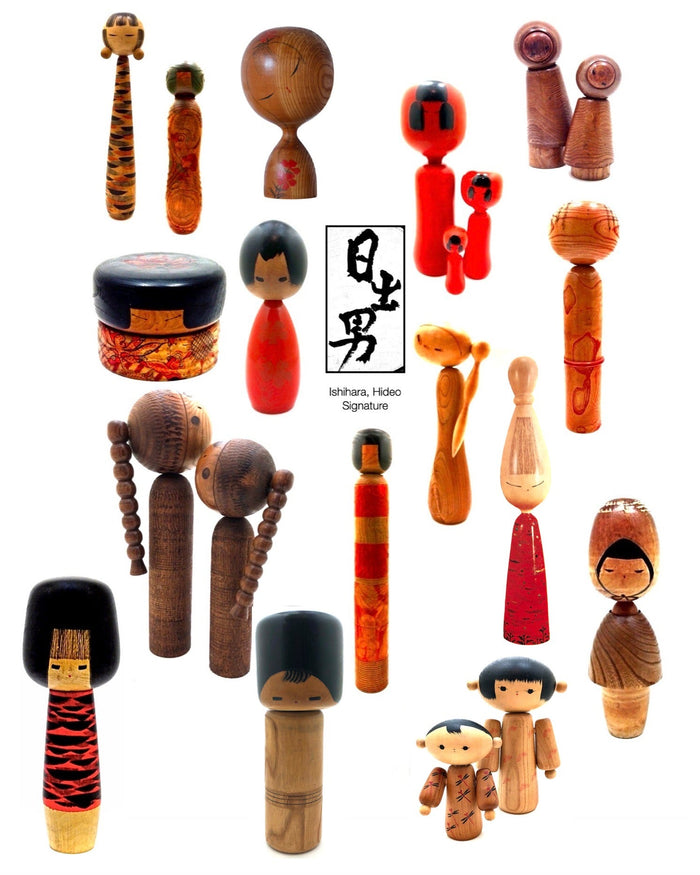
Artisan
Woodworker: Ishihara, Hideo
1925 - 1999
Biographical History:
Hideo graduated from Tohoku University with a degree in science. His grandfather was Iwataro Onuma, the Kokeshi artist credited with originating Naruto Kokeshi, perhaps the most famous style or strain of traditional Kokeshi types. Upon recovering from his illness, he moved to Sendai and began making Sosaku Kokeshi, and in ten years (1959-1969). During his medical treatment, he studied painting under Genichiro Inokuma. He lost interest in the traditional Kokeshi forms for he felt they were stagnating by family standards, and became an avid proponent of Sosaku Kokeshi allowing him the artistic freedom to experiment with various designs and forms. In 1964, he organized the Poetic Craft Exhibition and received more than sixty awards, including the highest honor, the Prime Minister’s Award. He was introduced to the twenty-three countries in Europe and America by NHK. He has sponsored 30 exhibitions in Japan including those at Matsuzakaya Nagoya and Ginza, and four exhibitions in overseas countries. He was one of the founders of the NKAHA, (Nippon Kokeshi Artistic Handicraft Association).
Collector's note – descriptive qualities, standard characteristics & ornamentation styles:
Ishihara-san’s dolls are based on many motifs found in nature and textile design. He loves portraying both young and old characters with differing hairstyles, (traditional and 1950s era). He illustrates numerous kimono styles in both painted form and carving and utilizes simple graphic treatment to emphasize the strong character of his dolls, which bring out the true nature of the wood materials through manipulation of the turned and carved wood. His dolls are always finished in a simple wax coating. It is also not unusual to see Hideo utilize sumi-e’ drawing of faces that have both the ‘one-stroke eye treatments, (Hitofude-me), as well as a variation of expressive renditions.
Explore & Learn More about Woodworker: Ishihara, Hideo